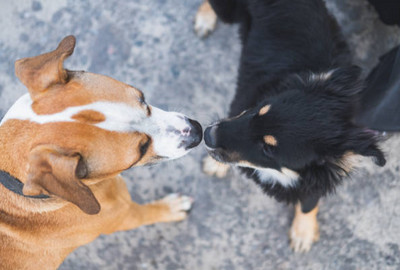 I recently received this question from a reader. Her situation brings up several tricky greeting/living situations, so I wanted to share my response with all of you. The way she writes her questions already lets me know that she’s more than a little worried and stressed about this. Anyone who’s had to deal with dominance issues can likely relate. It ain’t fun.
I recently received this question from a reader. Her situation brings up several tricky greeting/living situations, so I wanted to share my response with all of you. The way she writes her questions already lets me know that she’s more than a little worried and stressed about this. Anyone who’s had to deal with dominance issues can likely relate. It ain’t fun.
We have 2 female show Miniature Bull Terriers aged 5 yrs and 3 yrs both intact. There were dominance issues when the younger girl matured, but nothing in the last 2 years. Our older girl is more reserved around other dogs, so we put her in back rooms when other dogs come over. Our concern is that we have two families returning their minis for re-homing. The first is a 4 yo neutered male whose family is returning to Europe. He’s reported being good with young kids, other dogs, cats, etc. But the second is an intact 2 yo female who has not shown aggression but is too rough with the owners’ two young children. Good around other dogs. Neither dog will be permanent but will likely be with us for 2 to 4 weeks. Are there actions we should take?
Introducing new dogs to your household, especially when there are already dominance dynamics does require careful management. You may already know all of this, but here are my thoughts:
Initial Introductions:
Neutral Territory:
If possible, introduce the new dogs to your dogs on neutral ground before bringing them into your home. This should help reduce territorial aggression.
Slow Introduction:
Allow the dogs to meet one at a time, starting with the neutered male, as he is less likely to challenge the established hierarchy.
Separate Spaces:
Create Safe Zones:
Ensure each dog has a separate, safe space to retreat to. This can be a crate or a different room to avoid constant interaction and potential conflicts.
Rotate Time:
Rotate the dogs’ time in shared spaces to prevent overstimulation and reduce the chances of altercations. (In reality, this may wind up being your best option if neutral introductions don’t go well.)
Supervised Interactions:
Monitor Closely:
Supervise all interactions between the dogs, especially during the first few days. Look for signs of tension or aggression and intervene immediately. (When it comes to possible aggression, I do NOT believe in the “Let them work it out” method.
Controlled Playtime:
Keep play sessions short and controlled to prevent rough behavior from escalating.
Maintain Routine:
Consistency:
Keep the feeding, walking, and playtime routines consistent for your dogs to reduce stress and anxiety.
Reinforce Training:
Use positive reinforcement to encourage calm and appropriate behavior from all dogs.
Behavioral Management:
Use Commands:
Utilize basic commands (sit, stay, come) to maintain control during interactions.
Professional Help:
I know the new dogs may only be there for up to a month, but if you notice any signs of severe aggression or dominance issues, consider consulting a professional dog trainer or behaviorist. It would be worth it for your sanity.
Gradual Integration:
Gradual Increase:
Gradually increase the time the new dogs spend with your resident dogs as they become more comfortable with each other.
If, at the end of the day, you wind up playing musical dogs “now-you-see-this-dog-now-you-don’t,” and just keep them separated, it’s more important that you keep your sanity and not have to worry about safety.
Hopefully, this will help you have a smoother transition and minimize the risk of dominance issues or conflicts.

Thank you so much, Karen Shanley, for sharing these practical tips! Your guidance provides valuable assistance to many dog owners, especially in managing dominant dog situations. I hope everyone can maintain patience and follow these suggestions when introducing new members, ensuring each dog lives in a safe and comfortable environment.
Whenever a new dog joins your family, one of the biggest fears is that the old dog in the house will bully him. As in the case of my former Alaskan, who was followed by a golden retriever puppy. At first the golden puppy was timid and the Alaskan liked to show his territoriality. This made me realise that introducing a new member to him was an important thing to do. So I think the author’s article is really good and inspirational for many people.
Thank you for your kind words. :)